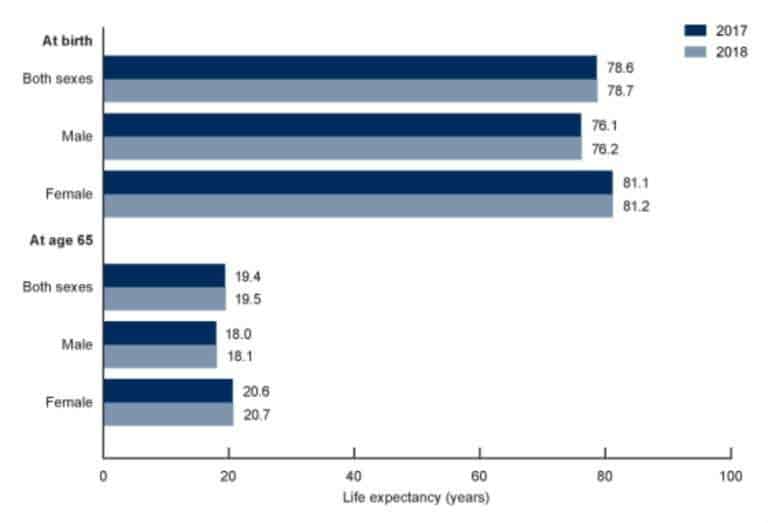
For the past four years, the life expectancy of US citizens has been steadily dropping. That was something almost unheard of since every developed country should be actually increasing its life expectancy, even if ever so slightly. This alarming trend seems to have been reversed in 2018, when Americans’ average life expectancy increased by one month to 78.7 years.
According to a recent report issued by the National Center for Health Statistics, nearly 2.8 million Americans passed away in 2018.
The improvement can be attributed to falling heart disease and cancer rates, which remain the two leading causes of death in the country, as well as a much needed 4% decline in drug overdose deaths. It’s the first time in 28 years that the rate of drug overdose deaths has declined.
“This news is a real victory,” HHS Secretary Alex Azar said in a statement. “The drop in overdose deaths shows that the President’s new level of focus on the opioid crisis, and the administration’s science- and community-based efforts to combat it, are beginning to make a significant difference.”

“That decrease in mortality from drug overdose definitely contributed to the increase in life expectancy. It wasn’t the leading contributor. The leading contributor was cancer. Cancer actually contributed more to that increase in life expectancy. Drug overdose would be second,” said Kenneth Kochanek, a researcher at the NCHS in Maryland.
Not everything about the report was positive. In 2018, the number of deaths from suicide and influenza actually rose pretty significantly as a result of an abnormally severe flu season that winter. While thousands of people die by suicide each year, millions more contemplate it. In 2017, 10.6 million American adults seriously thought about suicide, 3.2 million made a plan, and 1.4 million attempted, according to the CDC.
This month, the American Foundation for Suicide Prevention announced it had activated “Phase II of Project 2025,” which aims to reduce the suicide rate by 20% over 10 years. The ambitious program is focused on four key areas: firearms, healthcare systems, emergency departments, and corrections systems.
The top 10 leading causes of death in 2018 were the same as in 2017, accounting for 73.8% of all fatalities in the United States.
- Heart disease
- Cancer
- Unintentional injuries, such as drug overdose deaths and car accidents
- Chronic lower respiratory diseases
- Stroke
- Alzheimer’s disease
- Diabetes
- Influenza and pneumonia
- Kidney disease
- Suicide
The report’s authors point to the fact that decreasing smoking rates, which curtailed cancer deaths, and the expansion of a nationwide drug treatment policy, which reduced drug overdose deaths, show that long-term prevention programs really do work.
In the future, if such programs are better funded, life expectancy — still below the 2014 peak of 78.9 years — could rise much more. For instance, drug overdose deaths continued to increase in California, Delaware, Missouri, New Jersey, and South Carolina. Hammering down drug prevention programs in such tests might provide a considerable lift in life expectancy.
In 2018, drug overdoses claimed a staggering 67,000 lives. Prescription painkillers are no longer the leading cause of overdose deaths. In the past decade, heroin — which now kills four times as many people than in 2000 — and then fentanyl, surpassed prescription opioid drugs as the main cause of overdose death. Since 2012, the rate of overdoses involving cocaine have more than tripled while methamphetamine death rates increased fivefold.
It’s worth noting that the U.S. population-employment ratio has been increasing, which means that more Americans may be less despairing about their life prospects than before. Of course, the rising number of suicides in the country suggests that employment isn’t everything.
Besides drugs, the last two decades have seen a dramatic increase in suicides and alcohol-related diseases. The three causes of death form a “death of despair” triangle, which can be seen as symptoms of declining quality of life. For instance, they signal job losses and hollowed-out towns. Faced with stress, uncertainty, poverty, and even boredom, many become vulnerable to substance abuse and mental health problems.
As such, the authors of the new report advise cautious optimism for this is just the beginning of a very long battle with addiction in this nation.









